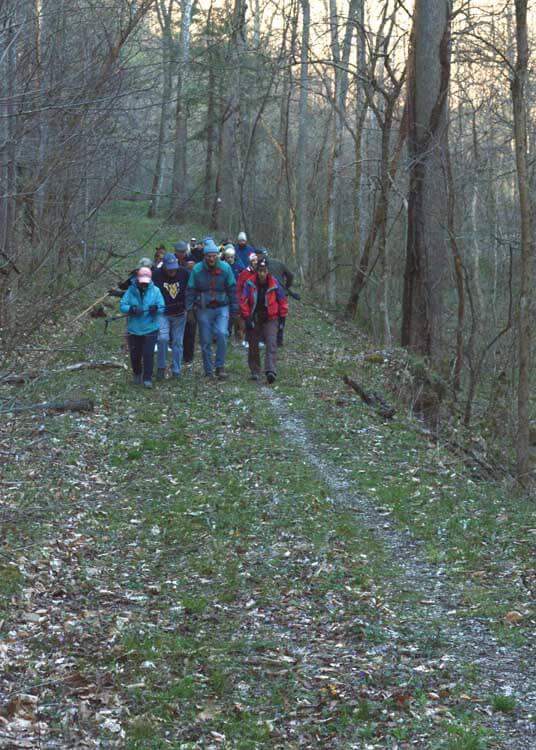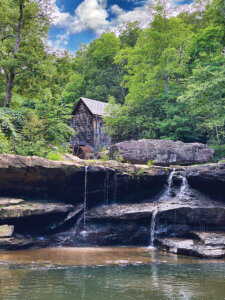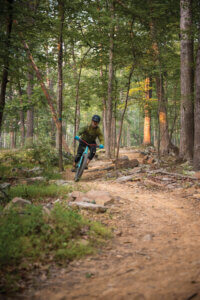
This story was originally published in the June 2016 issue of Wonderful West Virginia, and was updated in May 2023 by Wonderful West Virginia staff. To subscribe, visit wonderfulwv.com.
Written by Zack Harold
Trails connect us with nature—but the best ones begin with human ingenuity.
Thwack. The mattock dug its sharp edge into the rocky ground. Shif. A round-head shovel slid into the dirt, lifting away a load of dirt to expose the rich brown soil beneath. Thwack. Shif. Thwack. Shif. Sometimes the old fashioned way is the only way. This is especially true when you’re building a trail.

photographed by Zack Harold
A band of 15 volunteers, fresh from their day jobs, hiked up the Teaberry Rock Trail in Kanawha State Forest, they followed the trail to the top of the hill and turned onto a new, as-yet unnamed hiking and biking trail. The mile-and-a-half-long path was mostly cleared last year, but parts of the route remained badly canted. This work party planned to spend the evening leveling out, or “benching,” those sections. “We had a bunch of go-getters,” says volunteer Doug Atkins of the crew. “We worked from 4:30 until dark.” By the time night fell, after hours of sweating and moving dirt, volunteers had leveled three-quarters of the trail. But their labors were not yet finished.
One of the trail’s entry points sits below an old gas well. Although the area was dry when volunteers first cut the trail, precipitation during the winter had turned it into a swampy mess. “Sometimes when you make a trail you don’t know what will pop up,” Atkins says. Volunteers are now planning to build a new entry point to bypass this section. That job will require another hike into the woods and more sweating over shovel and mattock.
Trails are avenues into the natural world. They transport us from our world of orderly infrastructure into a world with a more ancient sense of order. Surrounded by nature’s beauty, it’s easy to forget those trails weren’t always there, but someone, at some time, cut these paths for us to wander through our summer mornings and cool fall afternoons.
Developing Paths
Trails have existed as long as legged creatures have roamed the earth. Even without the benefit of tools or pre-planning, humans and animals forged paths simply by following the same routes over and over again. Our ability to build roads advanced as civilizations developed, leading to grand boulevards, promenades, and interstate systems, but the idea of a trail in the woods built entirely for recreation is a relatively recent invention.
While mankind has long appreciated a leisurely stroll, it wasn’t until industrialization took hold in the 19th and 20th centuries—when workers left behind life on the farm for dim, dirty, and often dangerous factories—that people began to fully realize the recreational benefits of a walk in the woods. After the Civil War, “outing clubs” began springing up around the United States. By the 1910s, boys and girls across the country were involved in scouting organizations created to teach values through outdoor activities.
The first section of what would become the Appalachian Trail opened in 1923. Ten years later, the U.S. Forest Service chief listed hikers in his annual recreational usage report for the very first time. That same year, the New Deal put unemployed, unmarried men back to work through the Civilian Conservation Corps, which eventually built thousands of miles of recreational trails across the United States.
Today there are more than 1,300 miles of trails in West Virginia’s state parks system alone. “Trails still remain our No. 1 source of recreation in the parks system,” says Brad Reed, deputy chief of parks and recreation for the West Virginia Division of Natural Resources (DNR). They’re used for a variety of heart-pumping endurance activities, from hiking to mountain biking to horseback riding. “Then you’ll see other folks who are very slow and taking in every nuance, identifying plants and spotting animals,” Reed says. “Folks want to be adventurous, but they also want to be safe. Our trails provide that for them.”

photographed by David McCormick
Some of West Virginia’s trails are paved with asphalt or gravel, although most are simply dirt paths. But don’t be fooled by their humble appearance. Even a dirt trail requires some sophisticated planning. Amanda Payne, trail systems program manager at Marshall University’s Rahall Transportation Institute, has a shortlist of things trail builders consider before the first shovel hits the ground. First, planners seek paths that disrupt existing habitats as little as possible. “You don’t want to put in this natural walking trail and cut down a bunch of trees to make it,” she says. The easiest way to do this is to follow a path that’s already been created by the animals that live nearby. Because they try to avoid expending any more energy than necessary, forest creatures are great at finding the easiest, most unobtrusive paths through even the thickest woods.
Following animal tracks is also a good way to set the trail’s grade. While some hikers enjoy a challenge, even the spryest outdoor athletes can tire of steep inclines and descents. Steep trails also are more dangerous and difficult to maintain, and the RTI advises trail planners keep grades between 5 and 12 percent and avoid pitches of more than 20 percent as much as possible.
Trails should also take users to points of interest: historic structures, unique rock formations, scenic overlooks, streams full of fish, or meadows frequented by deer. “You want the trail to be in a place that creates a level of enjoyment for the guests,” says Reed at DNR. Most of these features are already known; it just takes a bit of research. Payne says she often relies on oral histories from locals. “There’s always an invested group around a certain trail or piece of property. That’s where you get the best history of a trail,” she says.

photographed by Josh Shackleford
Heavy Lifting
Once a route is settled, it’s time to go about building the trail. Chainsaws and axes clear big trees out of the way so workers can go through with smaller tools like edge trimmers to remove underbrush. Benching comes next and can make up two-thirds of the work. Sometimes it is done with shovels and mattocks, but for particularly difficult stretches, workers take in small pieces of heavy machinery like backhoes to do the job. Big jobs like this are often paid for with grant money—funded by the federal government through gasoline taxes collected on recreational vehicles, and funneled to state agencies, local governments, and nonprofit groups through the state Division of Highways.

photographed by Zack Harold
But even once a trail is completed, the work is far from over. Simple as they may be, these paths require frequent maintenance. DNR provides general direction for stateowned trail maintenance, but the work of keeping trails open and accessible largely falls to the maintenance staff of individual parks. After a bad winter, for instance, trails can be rendered impassable by uprooted trees, landslides, and erosion.
While park employees handle the majority of the heavy lifting, some parks, like Kanawha State Forest, also have passionate groups of volunteers who give their time to keeping the trails in top shape. “We’ve got a lot of help up here,” says Kevin Dials, Kanawha State Forest superintendent. Atkins agrees: “We wouldn’t do it if we didn’t like it. I like being in the woods. I like the exercise.”
A Serene Retreat
Around the time Atkins and his crew were leaving Kanawha State Forest after an evening of work on their unnamed trail, members of the Kanawha Trail Club came trudging out of the woods in a different section of the park. They had gathered about two hours earlier for one of their regular “night hikes.”
Hike leader Barb Koster guided the pack of 26 people, plus a few dogs, more than a mile into the woods. Some chatted amicably with their companions. Others studied the wildflowers and other plants growing along the way. At one point, the troop stopped in silence to listen for nocturnal birds and animals.
It wasn’t quite dark when the hikers returned to their cars—it had been more of a dusk hike than a night hike. But during that short stroll, the group was transported into the thick of nature. They allowed themselves to slow down and appreciate their surroundings. They separated themselves from the sights, sounds, and smells of a manmade world—all with the assistance of a manmade path through the woods.













